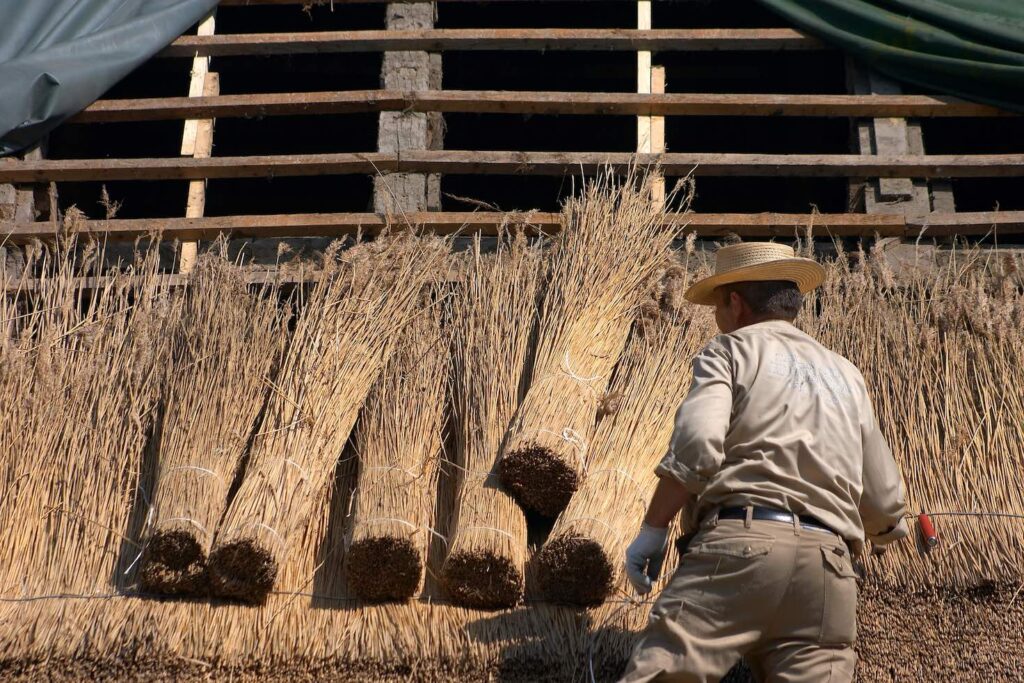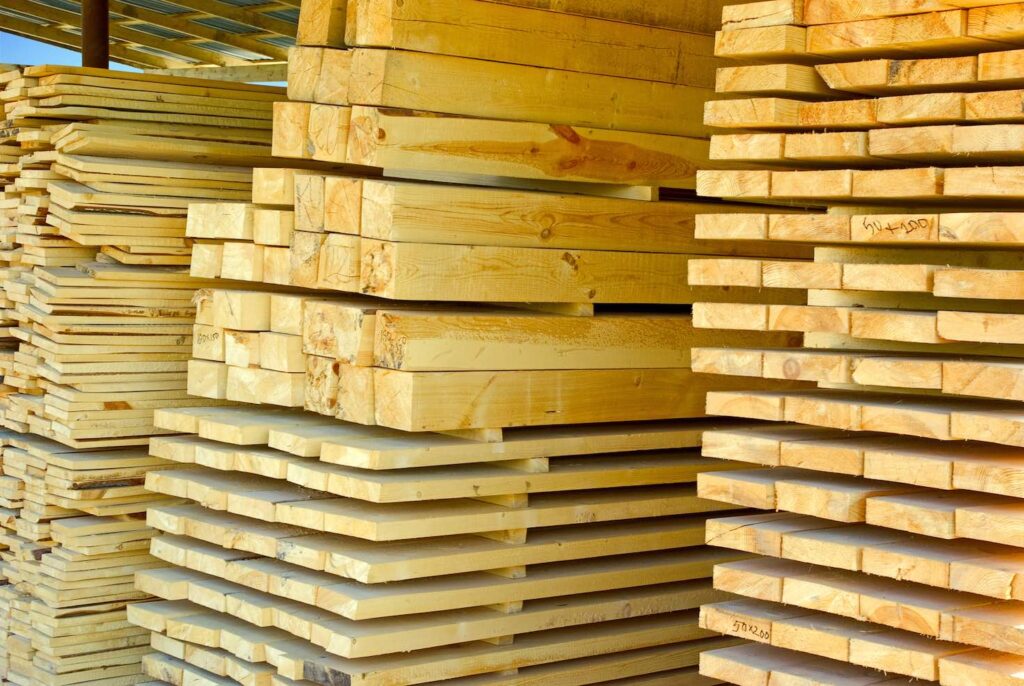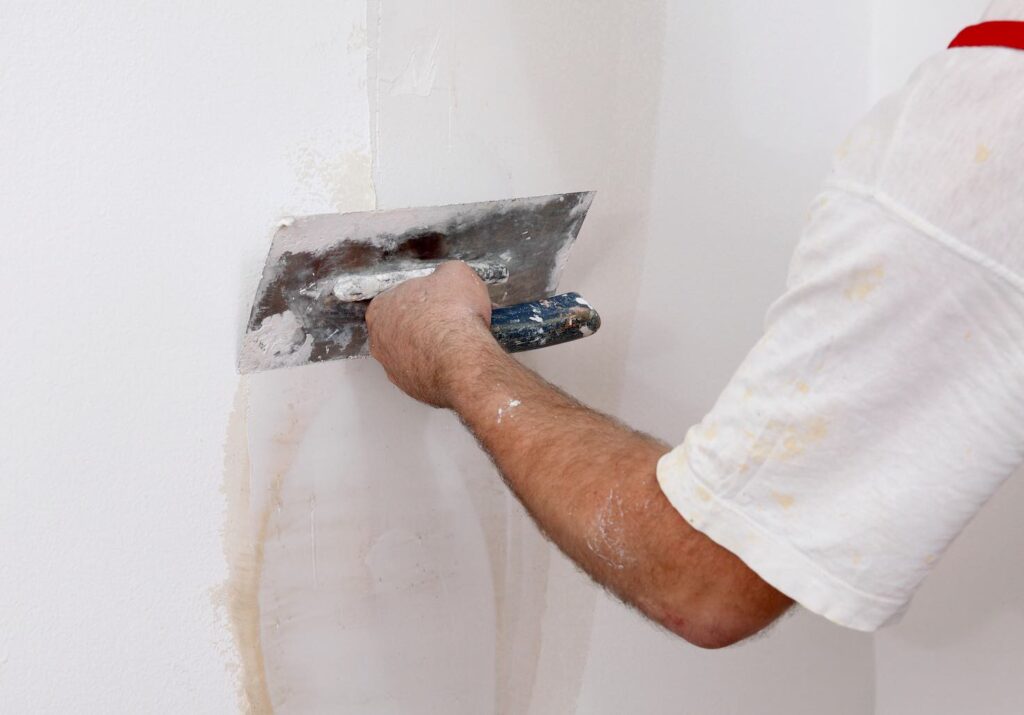21 Building Materials And Their Uses
Written by Aron Marriott-Smith • in Building Materials

Building materials are the essential components used in construction, from commercial and residential buildings to bridges and roads. The right choice of construction materials is an essential part of any construction project as they ensure the durability and strength of the finished product. In this article, we will explore the different types of building materials and their uses.
Concrete
Concrete is the foundation of modern construction; it’s a composite material used for foundations, walls, floors, and pathways. It is a durable and versatile material.
Concrete is a composite material made from a mixture of water, cement, sand, and aggregates (such as gravel or crushed stone) that hardens over time to form a strong and durable material. It is used in construction for foundations, walls, floors, and sidewalks due to its durability and versatility.
Bricks & Blocks
Bricks and concrete blocks are, of course, commonly used to make structural and decorative walls. There are thousands of unique varieties of brick in all manner of sizes and compositions. Bricks are primarily made from clay, which is moulded into rectangular blocks and then “fired” or baked at high temperatures to increase their strength and durability.
Bricks are favoured for building walls because they are relatively inexpensive, easy to install, and resistant to fire, pests, and weathering. Some common types of bricks include common bricks, facing bricks, firebricks, and clay pavers.
Wood & Timber

Wood is used extensively in construction for framing, flooring, doors, windows, and decoration. It’s a versatile and renewable material, used for thousands of years, and it’s still a popular choice today. In fact, wood is one of the most widely used building materials in the world.
As a natural resource, wood can be replenished through sustainable forestry practices. This means that, unlike many other building materials, wood can be used without depleting the earth’s resources.
Overall, wood is a fantastic building material – it’s strong, lightweight, and versatile. You can mould it into any form and finish it to get your perfect look. Sure, it has a few downsides – it can rot, decay, or get damaged by fire and bugs if not properly cared for. But with a bit of attention, wood proves to be durable and enduring. Plus, it’s a big win for sustainability lovers and those who fancy variety and aesthetics since there are so many types to choose from.
Steel
If concrete is the foundation of modern construction, then steel is the backbone. We see it as beams, columns, and everywhere else that needs sturdy support. Steel, an alloy of iron, carbon, and other elements like manganese or chromium, is chosen for its high strength, resilience, and flexibility.
The strength and hardness of steel depend on its carbon content while adding other elements boosts features like heat resistance or corrosion tolerance. You’ll find steel in everything – from massive buildings and bridges to your everyday appliances and tools. That’s because it’s not just versatile and reliable; it’s downright vital in today’s industry.
Glass
In construction, glass is used for windows and facades, allowing natural light into buildings. Glass is an expensive material due to its production process and fragility.
Despite its cost, glass is a mainstay in modern buildings and architecture thanks to its aesthetic appeal and energy-efficient properties. It also offers numerous design options to architects as it can be reinforced, laminated, tinted, and curved into various shapes. In addition to windows and facades, glass is also used for interior walls, skylights, staircases, and partitions. Glass has many benefits, but it requires proper maintenance and cleaning to ensure its longevity and safety.
Stone
Stone, a go-to for cladding, flooring, and decor, gives any space a timeless and natural touch. Stone weatherproofs and provides insulation for buildings – as well as boosts visual appeal. There’s a whole palette to choose from, including granite, marble, limestone, and slate, each offering unique hues, textures, and patterns.
You’ll often find stone underfoot too. Durable and resistant to heavy foot traffic, stone flooring exudes elegance. It’s a favourite for connecting indoor spaces with outdoor patios and pathways, providing a seamless flow.
One big plus about stone is its organic, enduring look. The colour variations, veins, and fossil imprints in each type of stone add to its visual appeal, allowing it to transcend fleeting design trends. It’s a beloved choice for both contemporary and traditional designs, all thanks to its versatile, durable nature and aesthetic charm.
Ceramics
Ceramics are most commonly seen as tiles, baked from raw materials like clay at high temperatures. Ceramics bring durability, heat resistance, and non-corrosive qualities to the construction table. You’ll spot them as tiles, sanitary fixtures, and roof tiles.
Ceramics tiles allow for a kaleidoscope of colours, designs, and finishes. They’re moisture-resistant, too, perfect for bathroom and kitchen use. Plus, a quick wipe-down is usually enough to keep them looking good. The catch? Ceramic tiles can be pricey. While the raw materials aren’t too costly, the creation process takes time, skill, and energy, driving up the price tag. And installation is a skill that can require a professional, which can add to the cost.
Despite the expenses, ceramics are still a favourite among homeowners and businesses. Their long lifespan and good looks justify the upfront cost, especially considering you won’t be replacing them as often as less durable alternatives. So, while ceramics might put a dent in your budget initially, their toughness, easy upkeep, and aesthetic charm make them a top choice for various applications.
Plaster

Plaster is used as a finish for walls and ceilings, and it gives a smooth, decorative touch to surfaces. You’ll mostly find it in interior design and construction, but it can also dress up exterior rendering. Making plaster isn’t costly – it’s just water, sand, and a binder like lime or gypsum. The skill and time needed for the application is where the cost comes in.
Common types of plaster include gypsum plaster, made from hydrated calcium sulphate, and lime plaster (also known as Venetian plaster or Stucco), which is a mix of crushed limestone and water.
Outside, plaster is used for rendering, giving walls a protective coating that can weather the elements and mask less-than-pretty construction materials like bricks or concrete blocks. Plus, it insulates buildings, keeping them cosy in winter and cool in summer.
Plaster has stood the test of time in the construction world, all thanks to its versatility, durability, and cost-effectiveness. Just bear in mind that plastering is an art – it takes years to master and is typically left to the pros to achieve that perfect finish.
Aluminium
Aluminium is used in the construction industry for windows, doors, rain guttering, and lightweight structures. Aluminium is corrosion-resistant and easy to work with. Aluminium is light, strong, flexible, resistant to rust, and 100% recyclable.
In terms of windows and doors, aluminium profiles are easy to install and require very little maintenance. They can also be painted or powder-coated to match the style of the home or building. The anti-corrosive properties of aluminium allow for long-lasting windows and doors that can withstand all weather conditions.
Aluminium’s high malleability makes it easy to be shaped and bent into complex shapes. And despite its lightweight, aluminium is incredibly strong, enabling it to support heavy loads and resist the impact of high winds. No wonder it’s also highly used in the aviation industry to make planes.
Asphalt
You’re likely already familiar with Asphalt’s use in road surfaces, but it’s also used for construction to seal roofs. Asphalt, also known as bitumen, is a sticky black substance that’s waterproof and highly durable.
In road construction, asphalt acts as a binder when mixed with aggregates to create asphalt concrete. This creates a resistant surface that is able to withstand heavy traffic and a variety of weather conditions.
In roofing, asphalt shingles are a popular choice due to their ease of installation and cost-effectiveness. Asphalt roofs are resistant to fire and water damage and offer excellent heat insulation, making them suitable for a variety of climates.
Another advantage of using asphalt is its ability to be recycled. When an asphalt road or roof reaches the end of its lifespan, it can be broken down and reused in new asphalt mixtures.
Gypsum
Gypsum is used for interior walls and ceilings, providing fire resistance and soundproofing. It’s essentially a softer plaster that doesn’t crack and is cheaper in labour and material cost. Gypsum is a naturally occurring mineral that has been used in building construction for centuries.
The main advantage of using gypsum for building walls and ceilings is its excellent fire resistance. Any water within gypsum vaporizes when heated, slowing the spread of fire through a structure. Naturally, this makes gypsum a popular choice for locations where fire safety is a key concern.
Gypsum also has a slew of other advantages. It has excellent soundproofing abilities. It’s also more durable and less likely to crack than traditional plater.
Gypsum-based products are also environmentally friendly. The raw materials required to make gypsum are abundantly available, and the end product is completely recyclable. The process of making gypsum also produces less carbon dioxide compared to other construction materials.
Rammed Earth
Rammed Earth construction is a technique where moistened soil is compacted into solid walls. It is an ancient and sustainable method. However, rammed earth is very expensive due to its high labour costs, ranging from $450 to $750 per meter squared, whilst a brick wall only costs $20 or less.
Despite its high cost, rammed earth is considered sustainable since it uses natural materials and less energy compared to brick or concrete walls. The natural ingredients used, which are mostly soil and a small amount of water, are abundant and renewable.
Rammed earth walls are solid and durable, capable of withstanding harsh weather conditions. The high thermal mass of these walls allows them to absorb and store heat during the day and release it slowly at night, helping to regulate indoor temperatures and reduce energy usage for heating and cooling.
Despite the high cost, the environmental benefits and the aesthetic appeal of rammed earth make it an attractive choice for many homeowners and builders. The earthy tones and unique textures of rammed earth walls can provide a distinctive and beautiful aesthetic that is not easily replicated with other materials.
Mud Brick
Mud bricks, or Adobe, are a blend of clay, sand, and straw, used since around 7000 B.C. for brick-making or plastering. Builders have used mud brick in walls and structures in ancient civilizations, including the Egyptians and the Indus Valley, thanks to their top-notch durability.
Making mud bricks is a piece of cake – mix earth with water, throw in some straw or other fibers, and then let the bricks dry in the sun. They’re great for insulation and humidity regulation, not to mention eco-friendly, cheap, and biodegradable. Sure, they’ve had a bit of a rep as an inferior material in modern construction, but that’s changing.
With the rise in sustainable, green building, mud bricks are making a comeback, especially in developing countries. As for plastering, mud plaster gives walls a sustainable, breathable, and pleasing finish, both indoors and out, standing up well to cement-based plasters.
Thatch

Thatch is the name given to a range of traditional roofing materials such as straw, reeds, or grass. Thatching is the craft of building a roof with thatch material by layering it in a way to shed water away from the inner roof. It is a very old roofing method and has been used in both tropical and temperate climates.
Although uncommon in modern construction, thatch is used to maintain and replace the roofs of traditional buildings in Europe. Thatch is also still alive and well in developing countries, usually in the form of reeds. It’s a cheap material but requires a lot of skilled labour to use. Thatch roofs also have a short lifespan of around 25 years before they must be replaced. Additionally, thatch is not fire retardant, so extra care is needed to prevent fire.
Bamboo
Bamboo is a versatile and renewable material normally used for flooring, walls, and even structural elements in some regions. It’s a popular choice in construction due to its strength, durability, and sustainability.
Using bamboo has a lower environmental impact than using traditional hardwoods. Its quick growth cycle and ability to regenerate after harvesting makes it a highly renewable resource. It also absorbs carbon dioxide at a much higher rate than other plants.
Furthermore, its natural beauty and warmth give a unique aesthetic appeal to any space. Other benefits include its resistance to insects and moisture, making it an excellent choice for humid environments.
Hempcrete
Hempcrete, a blend of hemp fibers and lime, is a super eco-friendly material used for insulation and wall construction. Its hemp content gives it strong thermal, sound, and impact resistance, while lime boosts fire and pest resistance.
Commonly used as insulation or filler between wooden beams or posts, hempcrete creates a sturdy envelope around a building’s interior. It can also be used as wall plaster, providing a natural, breathable surface that balances humidity indoors.
Hempcrete’s green credentials are top-notch. Its production uses little energy, emits minimal greenhouse gases, and hemp absorbs lots of CO2, shrinking its carbon footprint. On top of that, it has a longer lifespan than many traditional construction materials, reducing waste and the need for non-renewable resources. Thanks to its durability, it also cuts down maintenance and refurbishment costs.
One downside – hempcrete isn’t suited for load-bearing uses due to its strength limitations. It usually needs a supporting frame or structure. But it shines in insulation and sustainability, outdoing many traditional materials.
Currently, hempcrete isn’t widely used due to regulatory, economic, and cultural hurdles, along with its slow drying times and initial installation costs. However, as environmental awareness grows and research into hempcrete continues, its use is set to rise.
Rubber
Rubber is used for construction purposes in flooring, particularly in high-impact areas such as gyms or playgrounds. It’s durable and resilient, providing a soft and cushioned surface that helps absorb shock and reduce injuries.
Additionally, rubber is slip-resistant, making it a safe option for areas where there is a higher risk of falls or accidents. Cleaning and maintenance of rubber flooring is easy, making it a practical choice for high-traffic areas. It can be made in various colours and patterns, allowing for customization to match the overall aesthetic of the space.
Compressed Earth Blocks (CEBs)
Similar to bricks but made of compressed soil, often used for affordable housing projects. CEBs are created using soil that is stabilized and then compressed using high pressure. These blocks are environmentally friendly and can be used to reduce the cost of construction.
CEBs provide an economical alternative to traditional building materials like bricks or concrete. They can be used to construct structures such as houses and schools, particularly in developing countries where other building materials may be too expensive or difficult to obtain.
These CEB blocks deliver on a number of fronts. They are durable, energy-efficient, and can withstand various weather conditions. They also have excellent thermal mass, keeping buildings cool during hot weather and warm in cooler climates.
Prefabricated Panels & SIPs
Prefabricated Panels, also known as structural insulated panels (SIPs), are building sections made off-site in factories, then transported to the building site to be assembled for efficient and quick construction.
The construction technique of using Prefabricated Panels significantly cuts down on build time and reduces waste. This is because the pannes are quick and easy to install. And because they are made off-site, they only use the raw material amounts needed for the building. The panels can be made from a variety of materials, including steel, wood, or concrete. They can include both exterior and interior walls and can be designed to include doors, windows, and additional architectural elements.
SIPs are composed of an insulating layer of foam sandwiched between two layers of structural material, usually oriented strand board (OSB). This makes them extremely strong, energy-efficient, and cost-effective. Moreover, because they are factory-built, they are consistently high quality.
Polycarbonate
Polycarbonates are a transparent material generally used for roofing and skylights, providing light transmission and insulation. They are also known for their high impact resistance and durability, despite being lighter and thinner than glass.
You can also find polycarbonates used in the manufacturing of safety glasses and bullet-proof glass. They have the ability to withstand temperature extremes, making them ideal in both hot and cold climates. They also provide UV protection, reducing the harmful effects of long-term exposure to sunlight.
Most polycarbonate products are also easy to install, maintain, and clean. But they can be more prone to scratching compared to other materials like glass and can become yellowish when exposed to the sun for a long period of time.
Ferrocement
Ferrocement’s a composite material made of cement, sand, and reinforcement mesh. It’s commonly used for thin-shell structures. The reinforcement mesh is often made of steel but can also be constructed from wire or fibreglass. This material is also known as Ferroconcrete or reinforced concrete, although these terms can also refer to different materials.
Ferrocement is characterized by its high strength and durability, as well as its ability to be moulded into complex shapes. This results in a high strength-to-weight ratio, making it popular in many construction applications. It was originally developed in the mid-19th century and was first used in boat construction. Today, it is used in a wide range of applications, including water tanks, housing, and other infrastructure.
One of the main advantages of Ferrocement is its cost-effectiveness, as it requires less cement and steel than traditional concrete construction. It also has excellent resistance to impact and environmental conditions, making it a sustainable choice for many projects.
The performance of Ferrocement is highly dependent on the quality of the workmanship, particularly the proper placement of the reinforcement mesh. Other challenges include the potential for corrosion of the steel reinforcement, as well as the need for skilled labour and special equipment for construction.
Final thoughts
When selecting the right building material for any construction project, it is important to consider factors such as cost, availability, durability, and environmental impact. The type of building being constructed will also play a significant role in determining the appropriate materials to use. For example, a commercial building will usually require different materials than a residential building.
Building materials are an essential part of any construction project, and choosing the right building products is essential for ensuring the strength, durability, and longevity of the finished product. By understanding the different building materials – types and their properties, construction professionals can select the appropriate list of building materials for every project.
Top FAQs
What are the most common building materials used in modern construction?
The most common building materials used in modern construction include concrete, steel, wood, brick, and stone. Each material has unique properties and advantages that make it suitable for specific building techniques and applications.
What are some naturally occurring building materials?
Natural materials such as timber, stone, many types of rock, and earth have been used in construction for thousands of years and continue to be popular today. They offer a sustainable and eco-friendly alternative to synthetic materials and can be used in a wide range of building applications.
What are some of the factors to consider when selecting the right building materials?
Some of the factors to consider when selecting building materials include their cost, durability, availability, environmental impact, and aesthetic appeal. Depending on the project, certain materials may be more suitable than others based on these factors.
What are the most popular building materials in the UK?
The most common materials in the United Kingdom are Bricks, Concrete, Wood and Timber, Steel, Glass, Stone, Plasterboard, and Insulation materials( including mineral wool, polystyrene, and polyurethane foam). Roof materials; roofing material in the United Kingdom can include clay or concrete tiles, slate, and metal sheets.

